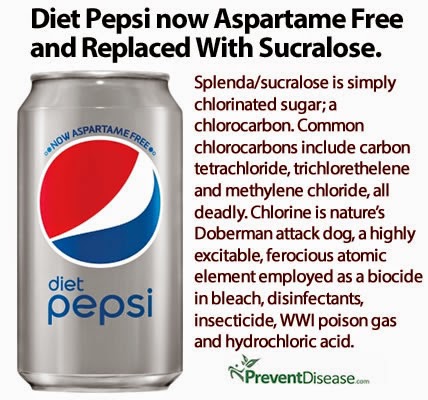Most Exhaustively Studied Substances In Food Supply With Over 100 Studies Supporting Safety?
By Marco Torres
Widget not in any sidebars
PepsiCo says it’s dropping aspartame from Diet Pepsi in the U.S. in response to customer feedback and replacing it with sucralose, another artificial sweetener commonly known as Splenda.
So is splenda any better than aspartame? In animals studied, Splenda reduces the amount of good bacteria in the intestines by 50%, increases the pH level in the intestines, contributes to increases in body weight and affects the P-glycoprotein (P-gp) in the body in such a way that crucial health-related drugs could be rejected.
Commenting on a report from Duke University in the Journal of Toxicology and Environmental Health, James Turner, chairman of the national consumer education group Citizens for Health, says “the report makes it clear that the artificial sweetener Splenda and its key component sucralose pose a threat to the people who consume the product. Hundreds of consumers have complained to us about side effects from using Splenda.”
The decision to swap sweeteners comes as Americans keep turning away from popular diet sodas. Competitor Coca-Cola said this week that sales volume for Diet Coke, which also uses aspartame, fell five percent in North America in the first three months of the year.
Monsanto, the creator of Aspartame knows all about the dangers. They fund the American Diabetics Association. Monsanto spends million of dollars lobbying the U.S. government to ensure its toxic products safely enter the food industry.
 Our pleasure in consuming sweet solutions is driven to a great extent by the amount of energy it provides. The greatest rewards in the brain are attributed to sugars compared to artificial sweeteners which offer only short-term pleasure at a huge health cost.
Our pleasure in consuming sweet solutions is driven to a great extent by the amount of energy it provides. The greatest rewards in the brain are attributed to sugars compared to artificial sweeteners which offer only short-term pleasure at a huge health cost.
Commenting on the toxicity of sucralose, Turner said, “it is like putting a pesticide in your body. And this is at levels of intake erroneously approved by the Food and Drug Administration. A person eating two slices of cake and drinking two cups of coffee containing Splenda would ingest enough sucralose to affect the P-glycoprotein” Although the effect of consuming Splenda does not result from a one time use, the side effects do occur after accumulated use. Turner also noted unmistakable evidence that Splenda is absorbed by fat, contrary to the claims of Johnson & Johnson.
Executives at Coke and Pepsi blame the declines in sales on perceptions that aspartame isn’t safe and hence the reason for the swap over to a substance no healthier and almost as toxic as aspartame.
John Sicher, publisher of industry tracker Beverage Digest, noted that attitudes about aspartame can be very negative. Using an online tool called Topsy that measures Twitter sentiment on a scale of 0 to 100, he noted “aspartame” got a 22 ranking, below a 38 ranking for “Congress.”
By comparison, “love” had a ranking of 96 and “Christmas” had a ranking of 88.
“Aspartame is the No. 1 reason consumers are dropping diet soda,” said Seth Kaufman, vice-president of Pepsi.
GOING FROM BAD TO WORSE?
According to the U.S. Food and Drug Administration, 11 to 27 percent of ingested sucralose is absorbed by the human body (FDA 1998). Research published by the manufacturer of sucralose (Roberts 2000) shows that when 8 healthy male adults where given sucralose (in 1 mg/kg amounts), between 10.4% and 30.6% of the sucralose was absorbed. In addition, 1.6% to 12.2% of the sucralose accumulates in the body.
The only reason aspartame has been forced out of soda is by increasing public awareness that it is both a neurotoxin and an underlying cause of chronic illness worldwide. Dr. James Bowen, Researcher and biochemist, reports:
“Splenda/sucralose is simply chlorinated sugar; a chlorocarbon. Common chlorocarbons include carbon tetrachloride, trichlorethelene and methylene chloride, all deadly. Chlorine is nature’s Doberman attack dog, a highly excitable, ferocious atomic element employed as a biocide in bleach, disinfectants, insecticide, WWI poison gas and hydrochloric acid.
“Sucralose is a molecule of sugar chemically manipulated to surrender three hydroxyl groups (hydrogen + oxygen) and replace them with three chlorine atoms. Natural sugar is a hydrocarbon built around 12 carbon atoms. When turned into Splenda it becomes a chlorocarbon, in the family of Chlorodane, Lindane and DDT.
“It is logical to ask why table salt, which also contains chlorine, is safe while Splenda/sucralose is toxic? Because salt isn’t a chlorocarbon. When molecular chemistry binds sodium to chlorine to make salt carbon isn’t included. Sucralose and salt are as different as oil and water.
 “Unlike sodium chloride, chlorocarbons are never nutritionally compatible with our metabolic processes and are wholly incompatible with normal human metabolic functioning. When chlorine is chemically reacted into carbon-structured organic compounds to make chlorocarbons, the carbon and chlorine atoms bind to each other by mutually sharing electrons in their outer shells. This arrangement adversely affects human metabolism because our mitochondrial and cellular enzyme systems are designed to completely utilize organic molecules containing carbon, hydrogen, oxygen, nitrogen, and other compatible nutritional elements.
“Unlike sodium chloride, chlorocarbons are never nutritionally compatible with our metabolic processes and are wholly incompatible with normal human metabolic functioning. When chlorine is chemically reacted into carbon-structured organic compounds to make chlorocarbons, the carbon and chlorine atoms bind to each other by mutually sharing electrons in their outer shells. This arrangement adversely affects human metabolism because our mitochondrial and cellular enzyme systems are designed to completely utilize organic molecules containing carbon, hydrogen, oxygen, nitrogen, and other compatible nutritional elements.
“By this process chlorocarbons such as sucralose deliver chlorine directly into our cells through normal metabolization. This makes them effective insecticides and preservatives. Preservatives must kill anything alive to prevent bacterial decomposition.”
Dr. Bowen believes ingested chlorocarbon damage continues with the formation of other toxins:
“Any chlorocarbons not directly excreted from the body intact can cause immense damage to the processes of human metabolism and, eventually, our internal organs. The liver is a detoxification organ which deals with ingested poisons. Chlorocarbons damage the hepatocytes, the liver’s metabolic cells, and destroy them.
In test animals Splenda produced swollen livers, as do all chlorocarbon poisons, and also calcified the kidneys of test animals in toxicity studies. The brain and nervous system are highly subject to metabolic toxicities and solvency damages by these chemicals. Their high solvency attacks the human nervous system and many other body systems including genetics and the immune function. Thus, chlorocarbon poisoning can cause cancer, birth defects, and immune system destruction. These are well known effects of Dioxin and PCBs which are known deadly chlorocarbons.”
Dr. Bowen continues:
“Just like aspartame, which achieved marketplace approval by the Food and Drug Administration when animal studies clearly demonstrated its toxicity, sucralose also failed in clinical trials with animals. Aspartame created brain tumors in rats. Sucralose has been found to shrink thymus glands (the biological seat of immunity) and produce liver inflammation in rats and mice.
“In the coming months we can expect to see a river of media hype expounding the virtues of Splenda/sucralose. We should not be fooled again into accepting the safety of a toxic chemical on the blessing of the FDA and saturation advertising. In terms of potential long-term human toxicity we should regard sucralose with its chemical cousin DDT, the insecticide now outlawed because of its horrendous long term toxicities at even minute trace levels in human, avian, and mammalian tissues.
Synthetic chemical sweeteners are generally unsafe for human consumption. This toxin was given the chemical name “sucralose” which is a play on the technical name of natural sugar, sucrose. One is not the other. One is food, the other is toxic; don’t be deceived.
GET READY FOR SUCRALOSE IN YOUR DIET SODA
PepsiCo says reformulated Diet Pepsi will start hitting shelves in August. The change only applies to the U.S. market and will affect all varieties of Diet Pepsi, such as Caffeine Free Diet Pepsi and Wild Cherry Diet Pepsi. It will not apply to other PepsiCo drinks, such as Diet Mountain Dew.
Representatives for Coca-Cola did not immediately respond to a request for comment.
Volumes for Diet Pepsi and Diet Coke began falling in 2005 and 2006, respectively, according to Beverage Digest. Volumes have continued falling since then, and accelerated in the last two years.
Sources:
globenewswire.com
cbc.ca
holisticmed.com
Marco Torres is a research specialist, writer and consumer advocate for healthy lifestyles. He holds degrees in Public Health and Environmental Science and is a professional speaker on topics such as disease prevention, environmental toxins and health policy. He writes where this article first appeared at Prevent Disease




